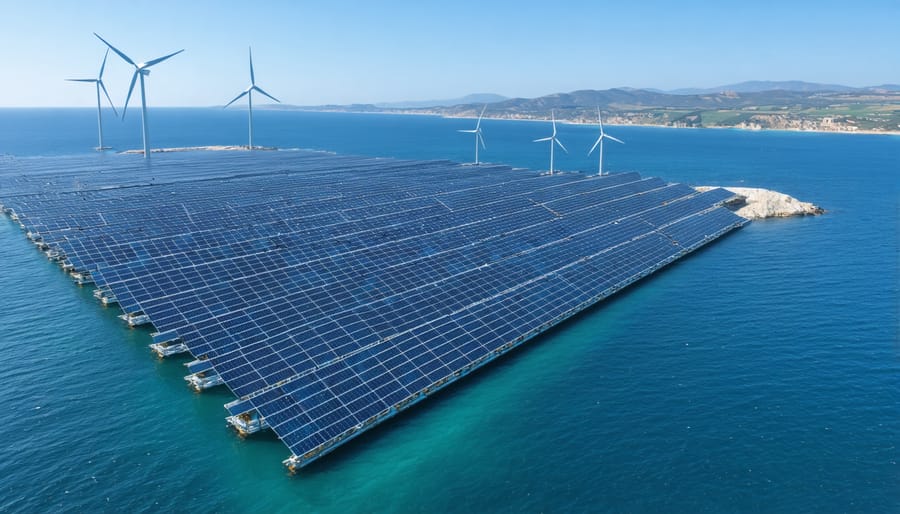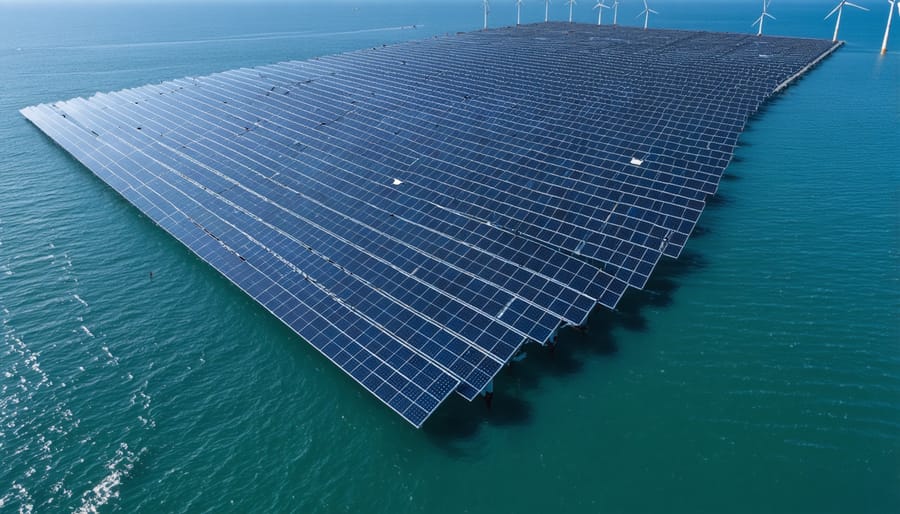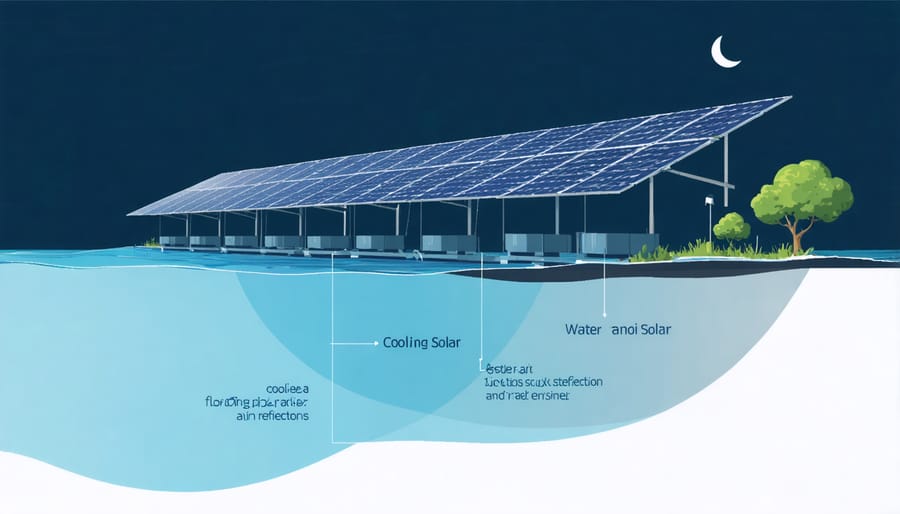Offshore Solar Farms Are Revolutionizing European Energy Production

Solar energy stands at the forefront of Europe’s renewable revolution, transforming how we power our homes, businesses, and industries. From traditional rooftop installations to innovative offshore solar power solutions, this sustainable technology offers compelling advantages that make it an increasingly attractive investment. As energy costs continue to rise and environmental concerns take center stage, understanding the key benefits of solar power becomes crucial for informed decision-making. This article explores three significant advantages that make solar energy a powerful choice for European enterprises and households: substantial cost savings through reduced electricity bills, enhanced energy independence from traditional power grids, and significant environmental benefits that align with EU sustainability goals. These benefits not only contribute to a greener future but also offer practical solutions to today’s energy challenges.
Maximum Space Efficiency in Maritime Environments
Integration with Existing Maritime Infrastructure
Solar energy systems are demonstrating remarkable synergy with existing maritime infrastructure, particularly through integration with offshore wind farms. This collaborative approach maximizes space utilization while sharing crucial transmission infrastructure, reducing overall installation costs. Port facilities are increasingly incorporating solar panels into their operations, powering everything from warehouse operations to electric charging stations for vessels.
The dual-use potential of maritime structures presents a significant advantage, as solar installations can be seamlessly incorporated into existing frameworks without requiring additional sea space. This integration extends to floating solar arrays that can be positioned between wind turbines, creating energy hubs that optimize power generation throughout varying weather conditions.
European ports like Rotterdam and Hamburg are leading examples of this integration, where solar installations work alongside traditional maritime operations. These installations demonstrate how renewable energy can enhance operational efficiency while supporting the maritime sector’s sustainability goals, creating a model for future development across European coastlines.

Coastal Area Utilization
Coastal regions across Europe are discovering an innovative way to maximize their maritime spaces through floating solar installations. These advanced systems, designed to withstand marine conditions, transform unused coastal waters into productive energy-generating zones. The technology combines specially engineered floating platforms with marine-grade solar panels, creating stable and efficient power stations that operate harmoniously with existing maritime activities.
Recent developments in countries like the Netherlands and Portugal demonstrate how coastal solar installations can generate clean energy while preserving valuable land resources. These floating systems typically achieve higher efficiency rates than land-based installations due to the natural cooling effect of water and reduced dust accumulation. Additionally, the proximity to existing grid infrastructure in coastal industrial areas often makes integration more straightforward and cost-effective.
The dual-use potential of coastal solar installations is particularly noteworthy, as they can be combined with aquaculture projects or positioned near offshore wind farms to share transmission infrastructure. This approach not only maximizes space utilization but also creates opportunities for integrated renewable energy systems that enhance overall grid stability and energy security.
Enhanced Energy Generation Performance

Cooling Effect Benefits
Water plays a crucial role in enhancing solar panel performance through its natural cooling properties. When solar panels operate at lower temperatures, they convert sunlight into electricity more efficiently. This cooling effect is particularly beneficial during peak summer months when panels typically experience reduced efficiency due to heat buildup.
Modern solar installations often incorporate innovative water-cooling systems that can improve energy yield by up to 15%. These systems work by circulating water across the panel surface or through specially designed channels, maintaining optimal operating temperatures even during intense sunshine periods. This process is especially effective in European climates, where the combination of strong sunlight and moderate temperatures creates ideal conditions for solar energy production.
The cooling effect also extends the lifespan of solar panels by preventing thermal stress and reducing wear on components. For industrial applications, this translates to significant long-term cost savings and improved return on investment. Additionally, the water used in cooling systems can be recycled for other purposes, such as irrigation or cleaning, making it an environmentally sustainable solution for temperature management in solar installations.
Reflection Advantages
Water surfaces present a unique opportunity to enhance solar energy generation through their natural reflective properties. When solar panels are installed near water bodies, they benefit from both direct sunlight and reflected light, potentially increasing energy yield by 5-10% compared to traditional land installations. This phenomenon, known as albedo effect, is particularly advantageous in regions with abundant water resources, such as coastal areas and lakeside locations.
In European installations, where maximising energy capture is crucial due to varying seasonal sunlight, reflection from water surfaces helps maintain consistent energy production throughout the year. For instance, floating solar installations in the Netherlands have demonstrated up to 12% higher efficiency rates during peak summer months, thanks to the combined effect of water cooling and surface reflection.
The reflection advantage becomes even more significant during early morning and late afternoon hours when direct sunlight is less intense. This extended period of enhanced light capture helps smooth out daily energy production curves, providing more reliable power output for grid operators and end-users. Additionally, the reflective properties of water surfaces can help compensate for cloudy conditions, common in many European regions, by capturing and redirecting diffused light to the solar panels.
Grid Integration and Supply Stability
Coastal Power Distribution
Solar energy has revolutionized power distribution in coastal regions, offering unprecedented efficiency and reliability for maritime communities. Modern coastal power distribution solutions integrate seamlessly with existing grid infrastructure while maximizing the abundant solar resources available along shorelines.
The strategic placement of solar installations in coastal areas provides multiple advantages. First, the natural cooling effect from sea breezes helps maintain optimal operating temperatures for solar panels, increasing their efficiency by up to 15% compared to inland installations. Additionally, coastal regions typically experience fewer obstacles to sunlight, resulting in more consistent energy production throughout the day.
Recent innovations in smart grid technology have enabled better management of power fluctuations, ensuring stable electricity supply to coastal communities. These systems utilize advanced weather forecasting and automated load balancing to optimize energy distribution, particularly during peak tourism seasons when demand surges.
European coastal regions have demonstrated remarkable success in implementing these systems, with several communities achieving energy independence during daylight hours. The combination of sophisticated monitoring systems and robust infrastructure has created a reliable framework for sustainable power distribution, supporting both residential and commercial needs while reducing transmission losses.
Industrial Application Benefits
Maritime industries are discovering remarkable advantages through offshore solar installations, particularly in European waters. Port facilities and offshore operations benefit from direct access to sustainable power generation, reducing their reliance on traditional energy sources and lowering operational costs. For instance, major ports in the Netherlands have successfully integrated floating solar arrays to power their cargo handling equipment and cold storage facilities, achieving energy cost reductions of up to 30%.
The seafood processing industry has emerged as another significant beneficiary, utilizing offshore solar installations to power their operations directly. These systems provide reliable energy for refrigeration units and processing equipment, ensuring consistent power supply even during peak demand periods. In Norway, salmon farming operations have reported increased operational efficiency and reduced carbon emissions after implementing offshore solar solutions.
Additionally, offshore drilling platforms and marine research stations are leveraging solar power to supplement their energy needs. This adaptation has proven particularly valuable in remote locations where traditional power infrastructure is limited or unreliable. The combination of offshore solar with energy storage systems ensures continuous operation of critical equipment and safety systems, while simultaneously reducing fuel transportation costs and environmental risks associated with conventional power generation methods. Recent implementations in the North Sea have demonstrated up to 40% reduction in diesel consumption for auxiliary power needs.
The transformative potential of offshore solar energy in Europe is undeniable, offering three distinct advantages that position it as a cornerstone of our sustainable energy future. The combination of efficient space utilization, enhanced energy yield through cooling effects, and grid stability benefits creates a compelling case for increased investment in offshore solar solutions. As European nations continue to pursue ambitious renewable energy targets, the expanding offshore solar sector presents unprecedented opportunities for both environmental protection and economic growth. With technological innovations driving down costs and improving efficiency, offshore solar installations are poised to play an increasingly vital role in Europe’s energy mix. The future outlook remains exceptionally promising, with projections indicating substantial growth in offshore solar capacity across European waters by 2030, supporting the continent’s transition toward a more sustainable and resilient energy infrastructure.
Leave a Reply